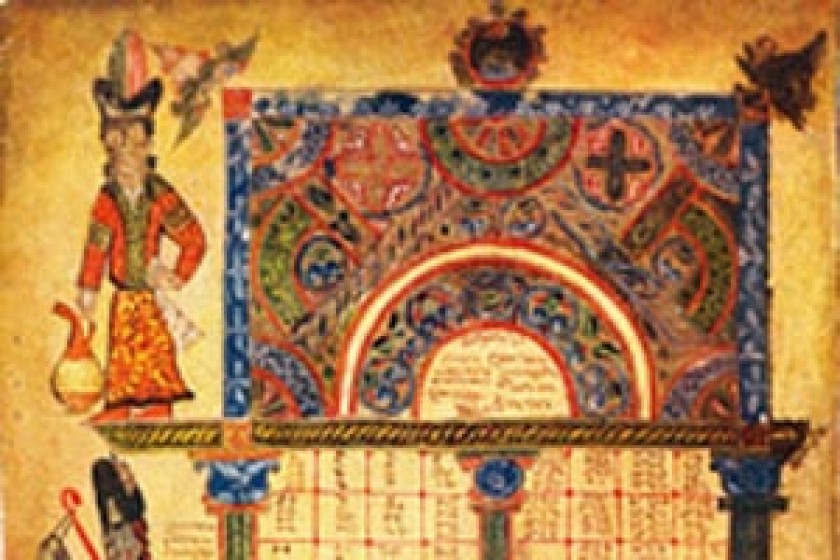
Sheranik, The First Armenian Pantomime
Sheranik
Ani at the beginning of 13th century. The citizens are unselfconsciously celebrating Barekendan. This is the single day in a year when absolutely everything is allowed, when consciousness dimmed by lavishly served wine breaks all limits, when paganism, having been strangled, hidden deep inside the virtuous Christians for a whole year, breaks out. The licentiousness of the feast would make Emperor Nero and his senators jealous.
Taking advantage of the carelessness of the citizens, the enemy creeps into the country and destroys it.
This is the historical period that artistic director of the Yerevan State Pantomime Theatre Zhirayr Dadasyan depicts in the play Sheranik.
Sheranik is the first ever "Armenian" performance in the history of Armenian Pantomime. The heroes come to life from Armenian miniatures. Their movements are straight and strict, without the multiple movements of the fingers typical of Japanese and Indian pantomime.
Sheranik is a result of many years of research and study.
Zhirayr Dadasyan: "I had the idea of this performance for a long time. I studied Armenian history and miniatures a lot. Once I found a very interesting book called Girq Grots by art critic and Matenadaran researcher Vigen Khechumyan. There are Armenian medieval miniatures, ancient medicine, calendars, and other things in the book. A separate section is devoted to the Ani miniatures and the Gospel of Haghpat. The Gospel was written in Haghpat, in 1211 but was illustrated in a monastery in the suburb of Ani.
"On one of the pages of the Gospel, Sheranik is depicted with a fish in his hand and above his head is written, "Sheranik, bring fish with you whenever you come." Ethnographers share the view that according to his garment in the miniature, Sheranik was a warrior.
"Sheranik's name is mentioned in the notes made on the bas relief of the Church of Saint Hovhannes in Ani. It says that before his death Sheranik willed all his property to the church.
"We can also find the name Sheranik (Sheran) among the translators of Ani's book of dream interpretations from Tajik into Armenian. The book belonged to a Tajik, a prisoner in the fort at Ani. This fact has led researchers to presume that Sheranik was the prison jailer. Khechumyan, in particular, is of the opinion that Sheranik was a commander of the Ani forces.
"In any case Sheranik was not an ordinary citizen, because not everyone could find their way onto the page of a Gospel, not to mention that the painter also wrote down his name."
So Sheranik is a warrior and on stage it is the beginning of the 13th century. In this era Ani had its second renaissance, when the Armenian brothers Ivane and Zachare won Ani back from the Arabs (the city had been under Arabic rule for about 120 years) and created an Armenian prefecture here.
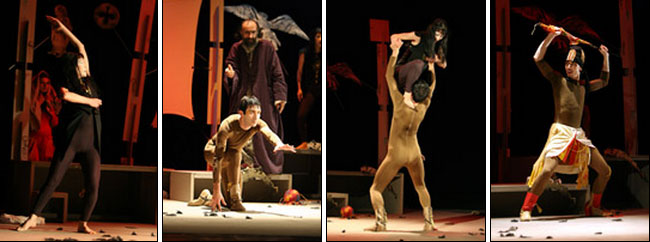
Construction and trade have revived; the Gospel is being illustrated. In 1207 a Church council is called at which a decision is taken to deny the Chalcedonian religion and return to the Apostolic Church. Ani becomes a classic medieval European city.
Ani was on the Silk Road, so silkworm breeding and batik was very well developed here. Sheranik wears silk clothes on the Gospel page. The costumes of the actors are also made of natural silk illustrated with the fauvist colors of Armenian miniatures.
Naturally, in these conditions the well-being of the citizens improves; people devote themselves to feasts and celebrations. Sheranik delivers a lion, which becomes the symbol of Ani.
In the play the inhabitants celebrate Barekendan in a big way. They mock Christian relics and even invite the priest to participate.
While the people are laughing at the priest and worshipping the Phallus, the Mongols invade Ani, seduce the lion and overcoming brief resistance, take the city. Sheranik kills the traitorous lion and enters the Church.
Zhirayr Dadasyan: "Throughout our history, we can observe an interesting thing; whenever our nakharars (ministers) saw the country being destroyed, they would become priests to at least preserve our intellectual wealth. That is why we often say our Church always had the role of State body. Essentially the Church has always been fairly worldly; besides preaching, it also intruded into its congregation's economic and social life. So Sheranik also goes into the church killing the lion.
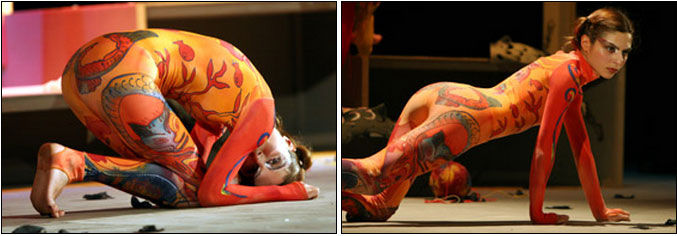
Why does he deliver a lion? A female lion used to be the symbol of Ani, so the lion had to be present in the performance. The Sheranik is built of a quantity of pieces and symbols. "Sher" has two meanings in Grabar (Old Armenian); the first meaning is a folk theatre sketch; the other is a lion.
The murder of the lion symbolizes here the change of worship. Sheranik kills the paganism in himself and embraces Christianity. I am of course talking of moral norms, since in the 13th century Armenians were already Christians."
At the end of the performance the female peacock that ascended previously returns and merges with Sheranik. The sharakan (Armenian hymn) Luys is heard, and the dead souls change into gharagyozes (characters in shadow theatre) with the revived bodies to be preserved in eternity and again become part of a miniature.
The Sibiu Festival
Sheranik has recently returned from its first tour, to the Romanian Sibiu International Theatre Festival. The Yerevan State Pantomime Theatre was the only one Pantomime theatre among some 80 theatres from 35 countries, almost all of them European.
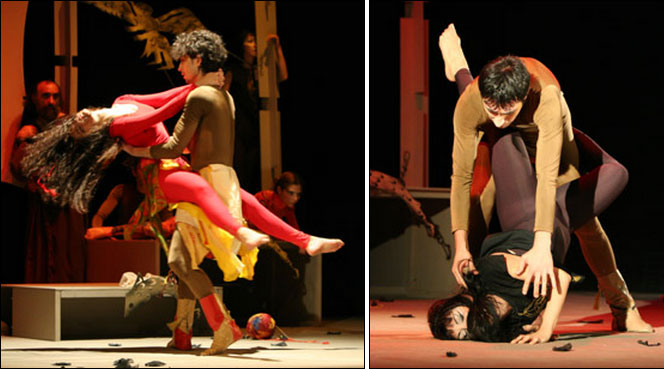
Zhirayr Dadasyan: "We were a bit worried about whether the Romanian audience would understand Sheranik , would catch the bait we put there. They did. At the press conference after the festival they said that the performance resembled Indian and Japanese theatre. They did not mean movements or form, because they are totally Armenian.
"The Sheranik's movements are based on the square. For me it is a very Armenian shape. One of our most beautiful churches, Saint Hripsime, is in the shape of a square; its dome is square as well, as is the base of the cross and also that of a circle that symbolizes unity. We took from Indian Katkhakali theatre just the arm folded at 90 degrees with open palm, which symbolizes the open chakras and is a sign of Buddha's victory.
"Saying Sheranik resembles the Indian and Japanese theatres people meant it was an ethnic performance. So they caught it.
"In the Romanian press there were interesting analyses, especially about the topicality of the performance. This is of course the most important thing about the performance.
Our pagan gods were all Persian gods. Embracing Christianity we prevented our nation from being merged with Persians and others and created new Armenian values. But what is going on in Armenia now is the same thing that happens in Sheranik . The people are confused, off their guard, devoting themselves to enjoyment, and they do not notice that the enemy is creeping inside. So the story could happen in any Armenian city nowadays.
The Romanian spectators liked the poetry of the performance, the presence of gharagyozes , which are again elements of Armenian medieval theatre, the often illogical but sincere movements. Participants and spectators at the festival, meeting us on the street, would greet us by showing the basic element of Sheranik, the square.
At the performance, world photographers were taking photos and then selling them. One of the best US theatre photographers, Scott Goldman, came to me after the performance and confessed that he had never taken pictures with such pleasure, that he did not even have to try to find a special angle to shoot from, because every movement was a whole painting. He gave us the photos he took for free."
What are we lacking?
Sheranik is just the beginning of "Armenian" pantomime. Next year Zhirayr Dadasyan is going to stage Girq Tcaghkants, based on a story by Derenik Demirchyan. This is a story of Parchment, its way to Matenadaran through the centuries.
It is not clear yet where the Pantomime Theatre is going to rehearse and then perform. For over 10 years the Theatre has not had its own place.
Zhirayr Dadasyan: "We rehearse at the Yerevan State Puppet Theatre and partly at the Young Spectator's Theatre in a very small room without the necessary conditions for pantomime. In both theatres they are very kind and helpful, but we have to work around their rehearsals, and so the creative process is interrupted constantly. What is the most insulting is that we have the same status; we are also a state theatre but are totally ignored by the state.
"In fact, we exist with the help of enthusiasts. But enthusiasm needs to be fed; otherwise it will be over very fast.
"In Armenia there is no cultural policy. In Sweden, for example, at the end of the year the government observes all the theatres. A theatre that got little money from the government but did a lot gets ten times more money for the next year. The theatre that did not put on a production gets deprived of the subsidy.
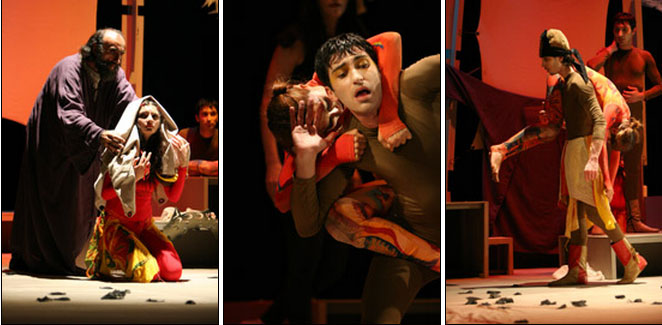
But in Armenia, in the eight years that I have been the Pantomime Theatre's artistic director, the Ministry of Culture has only assisted with the travel costs for Sibiu festival and partly funded the production of Sheranik.
"Armenia is a chamber country. If we cannot afford big theatres let us have small chamber theatres of different genres. Pantomime theatre is a chamber theatre. Tourism is getting more and more developed in Armenia so to have this theatre is profitable for government from this point of view as well. Foreigners go to the Vernissage and buy dolls in Armenian taraz (national dress). And here we have the same doll, alive, playing. And last but not least, this theatre does not need translating.
"The performances of the Pantomime Theatre are the souvenirs foreigners take with them from Armenia in their souls. About two years ago there was a British person who came to Armenia to participate in an Economic Cooperation Forum. His friend, who had been working in Armenia for a long time, advised him to visit three places in Armenia for sure: Echmiadzin, Geghard Monastery and the Pantomime Theatre.
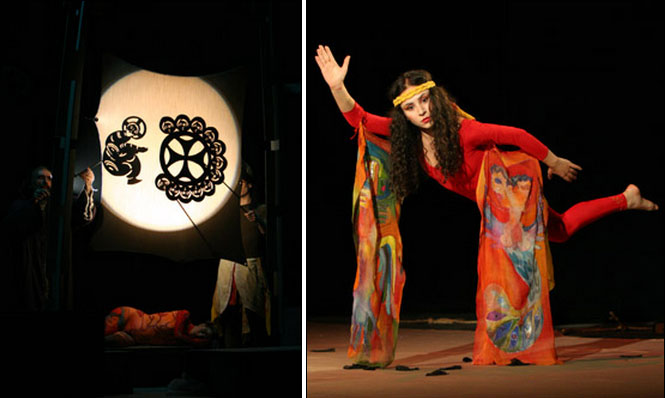
"We are included in government trips, for examples when there are Armenian Days in foreign countries. We have been to the United Arabic Emirates, Germany; we are going to Russia in September and then to France. We have a product to show and we need no translation. But whenever it comes to our problems, they forget us."
Dadayan spoke and wrote a lot about this problem to different officials and received different promises. The last promise came from the previous Minister of Culture - to add two stories to the building in the Sundukyan's Theatre's backyard and give it to the Pantomime Theatre. But Gevorg Gevorgyan was replaced before he had time to keep his promise. The current minister promises to continue the initiative. Perhaps this time it will turn out, unless of course this minister is also fired in a couple of months.
 Videos
Videos Photos
Photos
Write a comment